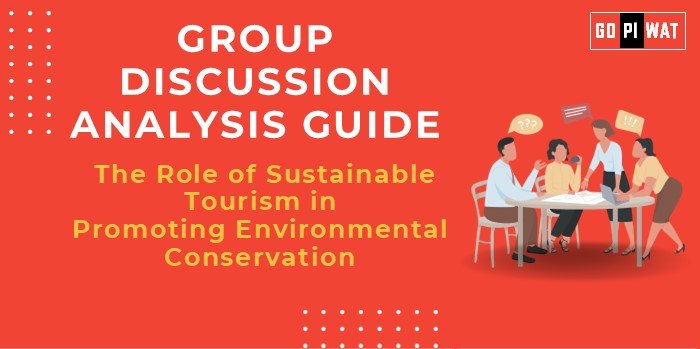🌍 Group Discussion (GD) Analysis Guide: The Role of Sustainable Tourism in Promoting Environmental Conservation
📖 Introduction to Sustainable Tourism
Opening Context: “In a world grappling with climate change and biodiversity loss, sustainable tourism emerges as a transformative tool, blending environmental conservation with economic growth. It’s a critical focus for nations seeking green development.”
Topic Background: Sustainable tourism integrates the principles of environmental stewardship, cultural preservation, and economic equity. Initiated globally in the 1990s, it gained momentum post-2015 with the UN’s Sustainable Development Goals (SDGs), particularly Goal 12: Responsible Consumption and Production.
📊 Quick Facts and Key Statistics
- Tourism’s GDP Contribution: 10.4% globally, highlighting its economic significance.
- Biodiversity Areas Impact: 60% of global tourism occurs in biodiversity-rich regions, stressing the need for sustainable practices.
- Carbon Footprint: Tourism accounts for 8% of global emissions, underscoring the environmental impact.
- Employment Creation: 300 million jobs depend on tourism worldwide, linking conservation efforts to livelihoods.
- UN Data: Over 100 countries have incorporated sustainable tourism in their national policies.
🌟 Stakeholders and Their Roles
- Government Bodies: Frame policies, create protected zones, and enforce regulations.
- Private Sector: Invest in eco-friendly infrastructure and promote sustainable practices.
- Local Communities: Preserve indigenous cultures and maintain eco-tourism activities.
- NGOs and International Organizations: Advocate for biodiversity conservation and support community-driven initiatives.
- Tourists: Adopt responsible travel habits to minimize ecological footprints.
🏆 Achievements and Challenges
Achievements
- Costa Rica: World leader in eco-tourism; 25% of its land is protected, with tourism contributing $4 billion annually.
- India: UNESCO-recognized eco-tourism models in regions like Sikkim.
- Global Collaboration: SDG alignment has encouraged cross-border eco-tourism projects.
- Community Empowerment: Ecotourism projects have elevated livelihoods, especially in rural and tribal areas.
Challenges
- Mass Tourism: Leads to resource depletion and habitat destruction.
- Lack of Standardized Guidelines: Global discrepancies in sustainable practices.
- Financial Viability: Eco-tourism projects face high initial costs, limiting underdeveloped regions.
🌍 Global Comparisons
- Success: Norway’s fjord management aligns tourism with climate neutrality.
- Failure: Over-tourism in Venice demonstrates the consequences of unsustainable practices.
Case Study: India’s Kaziranga National Park: Increased tiger population through controlled eco-tourism.
💬 Structured Arguments for Discussion
- Supporting Stance: “Sustainable tourism fosters economic growth while conserving natural and cultural assets.”
- Opposing Stance: “Implementing sustainable tourism is costly and often lacks measurable environmental impact.”
- Balanced Perspective: “While challenging to scale, sustainable tourism is crucial for long-term environmental and economic stability.”
⚡ Effective Discussion Approaches
- Opening Approaches:
- “Did you know tourism contributes 8% to global emissions? What if we could change that through sustainable practices?”
- “Costa Rica’s eco-tourism model shows how tourism can preserve 25% of a nation’s biodiversity.”
- Counter-Argument Handling:
- Use data-backed responses like emphasizing the ROI of sustainable tourism in countries with thriving eco-tourism industries.
🔍 Strategic Analysis of Strengths and Weaknesses
- Strengths: Promotes biodiversity and cultural heritage, aligns with global sustainability goals.
- Weaknesses: Requires high initial investments, may alienate mass-tourism-dependent economies.
- Opportunities: Adoption of green technologies in tourism, expansion into untapped biodiversity hotspots.
- Threats: Climate change disrupting ecosystems, resistance from stakeholders dependent on unsustainable practices.
🎓 Connecting with B-School Applications
- Real-World Applications: Projects on carbon-neutral tourism, supply chain management in eco-lodges.
- Sample Interview Questions:
- “How can sustainable tourism contribute to India’s economic growth?”
- “Evaluate the role of technology in sustainable tourism.”
- Insights for Students:
- Understand the nexus of tourism, economy, and environment.
- Explore opportunities for social entrepreneurship in eco-tourism.


